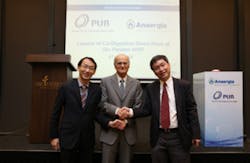Singapore wastewater plant to generate energy from water sludge, food waste
PUB, Singapore’s national water agency, is building the country’s first co-digestion plant to enhance energy generation from used water sludge and food waste.
The agency said last week that it had teamed up with Anaergia, a Canadian company that specializes in recovering value from waste in the municipal, industrial and agriculture sectors worldwide.
Officials expect the new facility to produce more biogas for electricity generation by co-digesting up to 40 tons of combined food waste and water sludge.
“This demonstration plant aims to validate the efficacy and cost-effectiveness of co-digestion implementation in Singapore,” explained Harry Seah, PUB’s chief technology officer. “It will provide the opportunity for the water reclamation plants to generate more electricity for process usage. This could potentially allow the used water treatment plant to achieve energy self-sufficiency, which is using only as much energy as the treatment process itself generates.”
Food waste will be collected from schools, hospitals and other premises in Clementi, western Singapore, enabling the plant to produce more biogas because of the higher calorific value of the waste. The facility will use the Omnivore process patented by Anaergia, which makes use of anaerobic digestion to break down organic materials without requiring oxygen to produce biogas.
If successful, the same process could be implemented at the future Tuas Water Reclamation Plant and the National Environment Agency’s Integrated Waste Management Facility.
The demonstration plant is currently under construction and is expected to be completed by September 2015.
